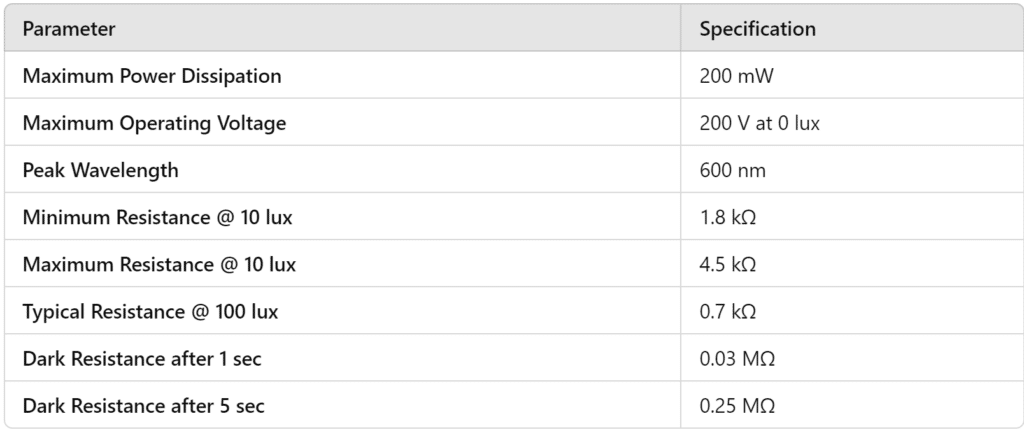Light Dependent Resistors (LDRs), also known as photoresistors, are integral to modern electronic systems where light sensitivity is required. These components are uniquely designed to vary their resistance in response to changes in light intensity, making them essential for countless applications across various fields.
From simple light-activated alarms to complex systems that adjust to ambient light conditions, LDRs provide a reliable and cost-effective solution. This article delves into the detailed specifications of LDRs, highlighting their functionality and the crucial role they play in electronic circuit design.
By understanding these specifications, engineers and designers can better harness the potential of LDRs to enhance the performance and efficiency of their projects.
Specifications of Light Dependent Resistors
LDRs exhibit a change in resistance based on the light intensity they are exposed to, making them highly versatile for a wide range of applications.
Key Specifications:
- Maximum Power Dissipation: This refers to the highest amount of power the LDR can dissipate safely within a specific temperature range. For instance, the typical maximum power dissipation is around 200mW. It’s important to note that derating may apply when operating above certain temperatures.
- Maximum Operating Voltage: At 0 lux, which essentially means in complete darkness, the maximum voltage that the LDR can handle is about 200V. This is critical as the LDR is semiconductor-based, and observing the maximum operating voltage is essential for safe operation.
- Peak Wavelength: LDRs are sensitive to specific wavelengths of light, with a peak sensitivity often at 600nm. This specification is vital for understanding which light conditions are most effectively detected by the sensor.
- Resistance under Illumination: The resistance of an LDR varies significantly under different lighting conditions:
- At 10 lux, the resistance can range from a minimum of 1.8kΩ to a maximum of 4.5kΩ.
- At 100 lux, a typical resistance value might be around 0.7kΩ.
- Dark Resistance: The resistance values in the absence of light are also crucial:
- After 1 second in the dark, the resistance might be approximately 0.03MΩ.
- After 5 seconds, this could increase to about 0.25MΩ.
These values indicate how the LDR behaves both in the dark and under various lighting conditions, which is essential for designing effective light-sensitive circuits.
Here’s the information about the LDRs presented in a table format for clearer understanding and reference:

This table provides a concise overview of the key specifications that are crucial when selecting and using LDRs in various electronic circuit designs.
Characteristics of Light-Dependent Resistors
LDRs are not linear devices.
Their response can vary significantly based on the wavelength of light they are exposed to. This is because the materials used in the LDR determine its sensitivity to different wavelengths.
Some LDRs may not respond to certain wavelengths at all, which is an essential factor to consider in applications requiring specific light sensitivity.
The response time of an LDR is another critical characteristic.
Typically, the resistance of an LDR will change within 8 to 12 milliseconds upon exposure to light. However, it takes several more seconds for the resistance to return to its original value once the light is removed, known as the recovery rate.
This property is particularly useful in applications like audio compressors, where the responsiveness of the component to changes in light can dynamically affect the compression.
Comparative Sensitivity
It’s important to note that LDRs are generally less responsive than other light-sensing devices such as phototransistors and photodiodes. A photodiode is a PN-junction semiconductor that converts light into electricity, characterized by its rapid response and efficiency. In contrast, an LDR, a passive device, operates without a PN junction and generally exhibits slower response times and lower efficiency.
Illumination Characteristics
The behavior of LDRs under varying light conditions can be illustrated as follows:
- In Darkness. The resistance is extremely high, often in the range of megaohms.
- Under Light Exposure. As light intensity increases, the resistance drops significantly to the range of kilo-ohms.

This characteristic makes LDRs ideal for applications where varying light conditions need to be detected and responded to, such as in automatic lighting systems, light-activated alarms, and many other light-sensitive devices.






